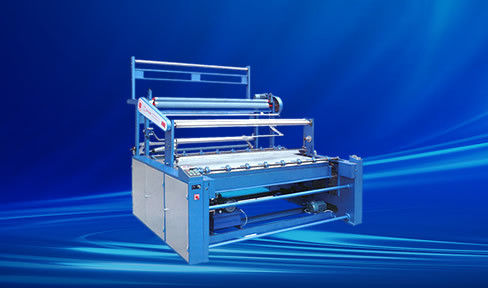From the textile machinery association weaving machinery branch annual meeting to see the direction of industry development
Release time:
2018-07-11
2018 has been half, the current situation of China's weaving machinery market?June 21, in the China Textile Machinery Association Weaving Machinery Branch 2018 annual meeting, the industry's hundred representatives gathered in Hangzhou, for the weaving machinery industry pulse, and jointly explore the direction of industry development.
2018 has been half, the current situation of China's weaving machinery market?June 21, in the China Textile Machinery Association Weaving Machinery Branch 2018 annual meeting, the industry's hundred representatives gathered in Hangzhou, for the weaving machinery industry pulse, and jointly explore the direction of industry development.
Multiple factors at home and abroad, the demand for weaving machines increased significantly
China Textile Machinery Association statistics show that in the first quarter of this year, by the national fiscal and financial policy adjustments, raw material price increases, fabric varieties diversification, accelerated industrial transfer, as well as the main international textile import market financial policy to restore stability and other factors, high-speed rapier loom, water jet loom, air jet loom demand for these three types of models are varying degrees of substantial growth.
In the first quarter of this year, the main domestic manufacturers sold a total of 2,234 high-speed rapier looms, a slight increase of 1.82%. Domestic imports of high-speed rapier looms 433 units, a sharp decrease of 53.84%. Including ordinary rapier looms, from January to March, China's domestic enterprises exported a total of 3,984 units, a sharp increase of 37.71% year-on-year. Major domestic manufacturers sold a total of about 13,000 water jet looms, an increase of 30.77% year-on-year. Water jet loom imports totaled 134 units, a year-on-year decrease of 51.97%. Domestic enterprises exported a total of 2,691 water jet looms, a sharp increase of 49.25%. The main domestic production enterprises sold a total of 4,964 air-jet looms, an increase of 100.73%; air-jet loom imports of 936 units, a year-on-year decrease of 6.96%; domestic enterprises exported a total of 564 units, an increase of 3.87%.
In addition to high-speed rapier looms, water jet looms, air jet looms, the demand for these two types of models were varying degrees of substantial growth, this phenomenon is formed in China's industrial restructuring and the “Belt and Road” construction of the strategic context: “three to one down a complementary” policies The implementation of the “Three Goes, One Down, One Catch” policy, especially the “de-capacitation” policy, has made the increase of PPI (Producer Price Index) turn from negative to positive since September 2016, and has continued to this day. The price of raw materials for production has risen sharply, and the inventory of downstream user enterprises has been reduced, resulting in the strengthening of the willingness of downstream users to purchase equipment.
The strengthening of the implementation of environmental protection policies also indirectly made the prices of production raw materials rise. In addition, the local government also with the strengthening of environmental protection policies to complete the task of capacity and industrial transfer, for example, Jiangsu Wujiang area will be eliminated in 3 years 100,000 water jet looms, while guiding the local user factory to replace other types of looms. This is also a reason for this year's air-jet loom demand soared.
Renewal of old machines, the demand in this area is due to changes in fabric varieties of user mills, on the other hand, is also due to the large number of machines purchased in 2010 and 2011 due to the expiry of the useful life of the machine.
The implementation of the “Belt and Road” initiative, the domestic manufacturers will target the market in Southeast Asia, South Asia, Central Asia and other countries, coupled with the region's major textile imports to restore stability in the market's financial policies and other factors, led to the domestic manufacturers of sales growth.
Policy adjustment + trade friction equipment exports face challenges
The current industry development hotspot than Xinjiang policy adjustments, the U.S. and China trade issues, China Textile Machinery Association President Wang Shutian expressed their own insights into this, he said, this year's policy adjustments, in line with the current development, in the construction, to be constructed and has been approved by the project is still the continuation of the original policy. Front spinning project input smooth, and later new weaving, knitting, printing and dyeing projects gradually form a complete system, need to continue to pay attention to.
U.S. textile consumption accounts for 17% of China's textile exports, the U.S. trade policy has a huge impact on China's economy and textile industry. Liu Ming, General Manager of Bejarra (Suzhou Industrial Park) Textile Machinery Co., Ltd. believes that technological trends and the development trend of the fashion industry should draw the attention of the textile industry, and at the same time, enterprises need to focus on the revolution of the business model, as well as the breakthroughs of the future technology.
Currently, China's textile exports are facing major challenges mainly from 12 aspects: rising labor costs, which used to rise by an average of 10% per year, are not sustainable for suppliers relying on low-cost competition; competition from other countries, especially low-cost countries in Southeast Asia; adjustments in traders' sourcing strategies and changes in the industrial chain under the threat of protectionism; and the more and more “unfriendly” the industry is. The increasingly “unfriendly” neighboring and global political environment has weakened confidence in long-term business cooperation; the aging of the population, with the number of employees decreasing year by year, and the number of low-skilled workers nationwide is estimated to decrease by 3 million per year; the increasing pressure on land, environmental protection, and financing, which has led to rising and unpredictable costs; the local government's adjustments to local planning and the impulse to upgrade industries, which have led to business disruptions. Upgrading impulse of local governments, with the risk of business interruption; Industrial transfer to foreign countries and inland areas; Decreasing confidence of private entrepreneurs and confusion about business inheritance; Upgrading of knowledge structure and application of digital technology; Lack of core competencies of the fashion industry, including branding, design, distribution and innovation; Business tilted towards large enterprises, with SMEs becoming under pressure.
Accelerated reshuffling of the international market Domestic demand potential for further release
To explore the future development direction of weaving machinery, it is necessary to understand the development of the global textile industry. Liu Ming believes that, according to the 2017 GHERZI International Textile Industry Trend Report, the major developed countries have lost their international competitiveness in the traditional textile industry since 2000 or before; China is expected to gradually begin to lose the international competitiveness of the industry after 2020, although the domestic demand market will improve rapidly; by 2050, the world's large textile market will be: China, India By 2050, the world's large textile markets will be: China, India, the United States, Indonesia and Nigeria. The textile industry is currently undergoing changes and faces the possibility of disruptive textile technologies. World sportswear sales growth is obvious, annual growth can reach 4.5%, of which, Europe and the United States demand accounted for 75%, predicted that the Asian region will also have a large increase.
Today, Asia is the global textile industry, the world's largest textile machinery market in the center of the huge trade of 180 billion U.S. dollars within the Asian region. The Asian market for textile machinery automation, high performance, energy-saving equipment demand is growing, and now the Asian textile into a new stage of development, is expected in 2025, intra-Asian trade will be doubled to 3500 U.S. dollars, by then, Asia will become the most attractive trade market.
Intelligent and interconnected direction is clear energy saving and high efficiency to strengthen performance
Li Xueqing, Deputy Secretary General of China Textile Machinery Association, said, “In 2017, domestic weaving preparation machinery continued to develop in the direction of high efficiency, energy saving, intelligence, and modular application. Preparation machinery pays more attention to the online detection and fine control of the production process, and improves the intelligent level of equipment with the help of the Internet, information technology, etc.; weaving machines continue to improve efficiency and product adaptability while developing in the direction of networking and intelligence, and combining with the expert system of the weaving process to establish a navigation database, laying the foundation for the further realization of the digital and intelligent weaving workshop. A number of enterprises made efforts on short-board devices such as opening equipment and warp threading equipment, with a view to improving the performance of domestic equipment. Environmental protection and energy saving is also the theme of 2017, and the 'environmental storm' promotes the reshuffling of production enterprises, as well as the updating and upgrading of equipment. Domestic weaving preparation machinery by trying to improve the drive mode, gas distribution technology, etc., in order to achieve the purpose of energy saving and gas saving; in addition, the water pollution problem of water jet looms has also been emphasized by a number of equipment enterprises, seeking solutions on the equipment side.”
As a well-known brand enterprise in China's textile machinery industry, Shandong Rifa Textile Machinery Co., Ltd. has taken every step for the industry's attention. “January to May, Shandong Rifa production and sales of various types of shuttleless looms more than 3,100 units, realizing sales revenue of 510 million yuan, is expected in 2018 can achieve production and sales of more than 8,000 units, sales revenue of 1.3 billion yuan. At present, Shandong Rifa has realized the synchronous growth of economic benefits and sales revenue, sufficient cash flow, declining assets and liabilities, and significant improvement in the quality of production and operation. Enterprises rely on high-end positioning, technological innovation, quality brand, advanced management initially realized a sustained, healthy and high-quality development. According to China Textile Machinery Association statistics, Shandong Rifa's shuttleless loom product market share in 2017 was 13.54%, ranking first in the industry.” Li Zijun, general manager of Shandong Rifa Textile Machinery Co.
In Li Zijun's view, Shandong Rifa's remarkable performance is mainly due to the successful practice of five aspects: first, to enhance the technical level of the loom relies on continuous investment in research and development and a steady stream of technological innovation; second, the quality of the healthy development of the quality first, and efficient input to protect the quality of the enhancement; third, the subdivision of the textile industry, plowing and servicing the market; fourth, the talent is the basis, the culture is the root; fifth, the strategic navigation of the industrial development. Responding to the national policy, intelligent green future.
Li Zijun said: “In the future, Shandong Rifa textile equipment continue to energy saving and environmental protection, intelligent, complete sets of the direction of the line, adhering to the ‘become an agile international company’ vision, through advanced technology, excellent management, positioning the global market objectives, Shandong Rifa to build a world-class shuttleless loom R & D and manufacturing base. shuttle loom R&D and manufacturing base.”
Stäubli, which has a say in the future direction of the weaving machinery industry, has been working intensively on weaving machine openings and weaving preparation systems. Currently, weaving mills around the world that produce high quality fabrics almost without exception use Stäubli dobbies or cam boxes as special equipment for their weaving machines, while Stäubli's pre-weaving warp preparation systems meet the various needs of the modern weaving industry.
According to Dai Rongbing, Manager of the Spinning Division at Stäubli (Hangzhou) Precision Mechatronics Co., Ltd, Stäubli specializes in high-productivity weaving technology and supports its customers through continuous innovation to ensure that they are able to improve productivity, efficiency and sustainability. “Stäubli's range of textile machinery products and services includes automated weaving preparation systems, bobbin opening solutions for heald frames and jacquard weaving, systems for carpet weaving, weaving systems for technical fabrics, and automation solutions for needle hosiery knitting machines, etc. The high performance and reliability of our products are suited to systems and solutions for the most demanding applications, with the end products covering fashion, home textiles, floor coverings The end products cover fashion, home textiles, floor coverings, automotive fabrics, protective equipment fabrics and industrial fabrics. Stäubli partners with customers around the world to provide personalized service and support to ensure efficient production and minimize downtime.” Dai Rongbing said.
As a representative of downstream user enterprises, Zhao Wenjun, Vice President of Black Peony (Group) Co. believes that the intelligent development of spinning machine enterprises is the foundation for realizing intelligent manufacturing. In recent years, Black Peony has collected various data in real time through information collection, machine networking, and for data processing, it adopts big data and cloud computing to strengthen intelligent learning and implement command control through standard execution, automatic detection, and intelligent commands.
Tag:
Previous article
Next article
Related News

Mobile:
Tel:
Add: Dongshe Town, Tongzhou District, Nantong City, Jiangsu Province
Contact: 86-13901468376 Mr. Zhu
Tel: 86-513-82506284 / 86-513-82506333
Fax: 86-513-82506666
E-mail: sales@ntzhongyi.com
Website: http://www.ntzhongyi.com
HUATAO GROUP
Online Message
Please fill in the form below, our staff will contact you within 24 hours and solve your problem as soon as possible.
Copyright©2024 Nantong Tongzhou Zhongyi Textile Machinery Co., Ltd.






